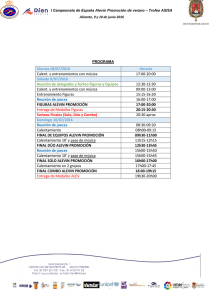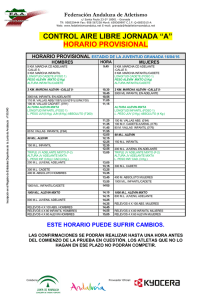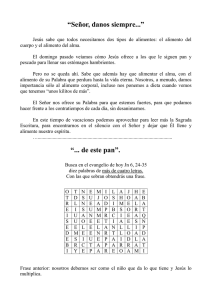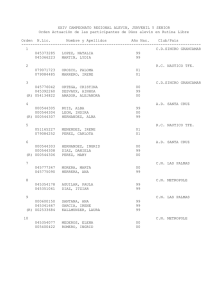Alimentary Biostoichiometry Toward a Bigger Productivity and a Low
Anuncio
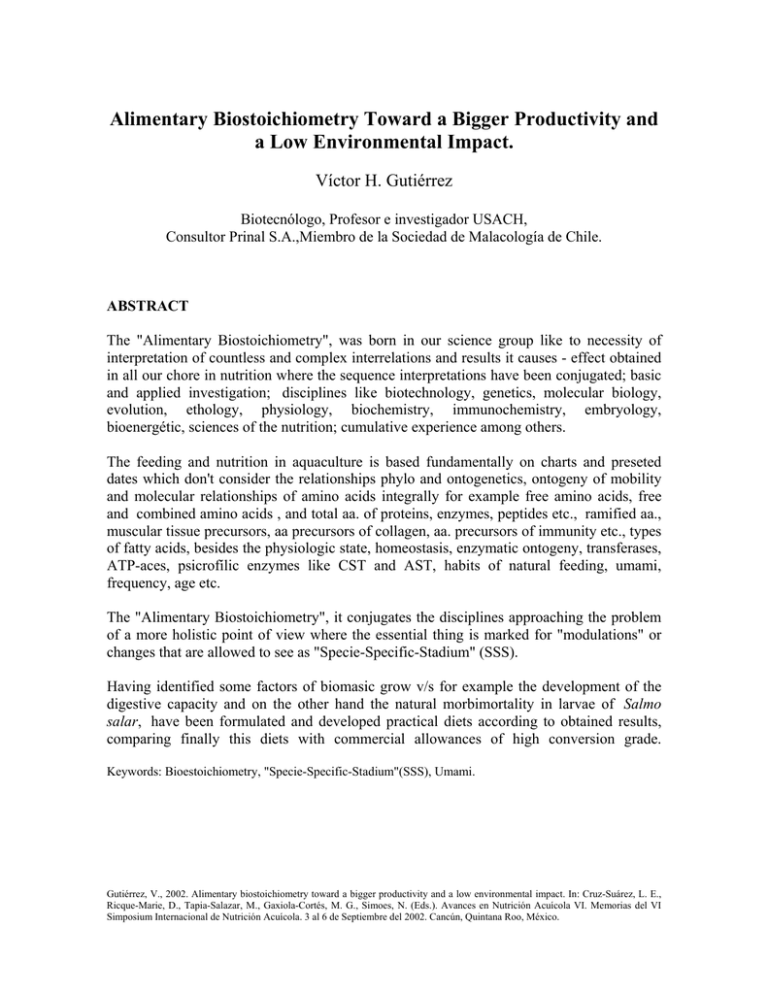
Alimentary Biostoichiometry Toward a Bigger Productivity and a Low Environmental Impact. Víctor H. Gutiérrez Biotecnólogo, Profesor e investigador USACH, Consultor Prinal S.A.,Miembro de la Sociedad de Malacología de Chile. ABSTRACT The "Alimentary Biostoichiometry", was born in our science group like to necessity of interpretation of countless and complex interrelations and results it causes - effect obtained in all our chore in nutrition where the sequence interpretations have been conjugated; basic and applied investigation; disciplines like biotechnology, genetics, molecular biology, evolution, ethology, physiology, biochemistry, immunochemistry, embryology, bioenergétic, sciences of the nutrition; cumulative experience among others. The feeding and nutrition in aquaculture is based fundamentally on charts and preseted dates which don't consider the relationships phylo and ontogenetics, ontogeny of mobility and molecular relationships of amino acids integrally for example free amino acids, free and combined amino acids , and total aa. of proteins, enzymes, peptides etc., ramified aa., muscular tissue precursors, aa precursors of collagen, aa. precursors of immunity etc., types of fatty acids, besides the physiologic state, homeostasis, enzymatic ontogeny, transferases, ATP-aces, psicrofílic enzymes like CST and AST, habits of natural feeding, umami, frequency, age etc. The "Alimentary Biostoichiometry", it conjugates the disciplines approaching the problem of a more holistic point of view where the essential thing is marked for "modulations" or changes that are allowed to see as "Specie-Specific-Stadium" (SSS). Having identified some factors of biomasic grow v/s for example the development of the digestive capacity and on the other hand the natural morbimortality in larvae of Salmo salar, have been formulated and developed practical diets according to obtained results, comparing finally this diets with commercial allowances of high conversion grade. Keywords: Bioestoichiometry, "Specie-Specific-Stadium"(SSS), Umami. Gutiérrez, V., 2002. Alimentary biostoichiometry toward a bigger productivity and a low environmental impact. In: Cruz-Suárez, L. E., Ricque-Marie, D., Tapia-Salazar, M., Gaxiola-Cortés, M. G., Simoes, N. (Eds.). Avances en Nutrición Acuícola VI. Memorias del VI Simposium Internacional de Nutrición Acuícola. 3 al 6 de Septiembre del 2002. Cancún, Quintana Roo, México. Victor H. Gutiérrez • 167 S” A I.- INTRODUCCION: V TI U OL V ” E ..” RE A. Y I B I N L La “Bioestequiometría Alimentaria”, grupo A ciencia como AS nace enOnuestro GE D C I V FIL GI una necesidad de interpretación y complejas A Ade innumerables L O L E L D A IO interrelaciones y resultados causa-efecto obtenidos en todo nuestro que UL ON B T I I C P I S P D hacer en nutrición las interpretaciones de C A han conjugado NE dondeRREEse ON C O I A A IIA secuenciación; básica como S L y aplicada; multidisciplinas PC investigación EN E ” E G . E . C O O T . biotecnología, genética, biología fisiología, NT “A ISetología, IEN molecular, evolución, O ON AS T S O ME O “H B A LLA AM bioquímica, “inmunoquímica, embriología, bioenergética, ciencias de la O DI E LM nutrición; experiencia práctica acumulada entre otras. DE A EZ FI J A “L I.- INTRODUCCION: • La alimentación y nutrición acuícola están basadas fundamentalmente en base a tablas y datos preestablecidos los cuales no consideran integralmente por ejemplo las relaciones filo y ontogenéticas, ontogenia de movilidad y relaciones moleculares de aminoácidos libres, libres y combinados, y aa. totales de proteínas, enzimas péptidos etc., aa. ramificados precursores de tejido muscular, aa. precursores de colágeno, aa. precursores de inmuno respuesta etc. ácidos grasos, además del estado fisiológico, homeostasis, ontogenia enzimática, transferasas, tripsinas sicrofílicas como CST y AST, hábitos de alimentación natural, horario, frecuencia, edad etc. La “Bioestequiometría Alimentaria” conjuga las multidisciplinas abordando la problemática de un punto de vista más holístico donde lo esencial está marcado por “modulaciones”o cambios que se dejan ver como “EspecieEstadio-Específico ” (EEE). Alimentary biostoichiometry toward a bigger productivity and a low environmental impact II.- OBJETIVOS: • Investigación ontogenética de relaciones moleculares de aa. libres y totales y ácidos grasos en Salmo salar a partir de gonias hasta larva día 25. • Comparar alimento formulado y extruído en frío (Alev-1) con Alimento Comercial de Alta Conversión (AL-AC). • Cuantificar Incremento Biomásico y Morbimortalidad. ACEPCIONES BIOLOGICAS Y EVOLUTIVAS “LA ONTOGENIA RECAPITULA LA FILOGENIA”... “LA FIJEZA DEL MEDIO INTERNO ES LA CONDICION DE LA VIDA LIBRE”...HOMEOSTASIS “EL SER MODIFICA EL AMBIENTE Y EL AMBIENTE MODIFICA AL SER”... 168 Victor H. Gutiérrez 169 CONSIDERACIONES ALGORITMICAS C.A.E A CARACTERISTICAS Asp Acidos Neutros Básicos Carga Hidrófilos Hidroafinidad (Polares) X X M I N O A C I D O S Glu Arg His Lys Cys Gly Ser Thr X X X X X X X X Asn Gln Tyr Ala Leu Val Ile Pro Phe Met Trp X X X X X X X X X X X X X X X X X X X X X X X X X X X X X X X X X X X X X X X X X X Hidrófobos (Apolares) Cíclicos Acíclicos Aromáticos Alifáticos Estructura Pequeño Medio Grande Tamaño Glicogénicos Quetogénicos Gli/queto. X X X X X X X X X X X X X X X X X X X X X X X X X X X X X X X X X X X X X X X X X X X X X X X X X X X X X MODULACION HIDROLITICA GROUP Serine trypsin like proteinase Serine alkaline proteinase Other serine proteinases Thiol proteinases Metal-chelator sensitive-neutral proteinases Acid proteinases 1 5 10 15 20 Phe- Val- Ans- Gln - His-Leu- CySOJI- Gly-Ser-His-Leu-Val-Glu-Ala-Leu-Tyr-Leu-Val-CySOJI-Gly-Glu-Arg-Gly-PheTrypsin (21) St.griegus (15) a-Chymotr.(21) Chymotr.C (49) Subtilis c. (50) Subtilis BPN¨(50) St.griegus C(28) St.fradiae 1b(19) Elastase (63) Myobacter (44) Clostripain (14) Papain (54) S. Venom (56) B. subtilis (57) Thermolisin (58) B. megaterium Ps.aur. (60) Pepsin (21) Rh.chinensis(64) Alimentary biostoichiometry toward a bigger productivity and a low environmental impact ESPECIFICIDAD DEL TRATAMIENTO HIDROLITICO Procedimiento Aminopeptidasa Carboxipeptidasa A Acción en Lado C Lado N Carboxipeptidasa B CNBr Tripsina Quimotripsina Termolisina Pepsina Lado N Lado C Lado C Lado C Lado C Lado N Especificidad Rn Extr. C,R = ácido, aromático, o alifático Extr. C,R = básico Rn = Met Rn = Lis,Arg,AE-Cis Rn = Fal,Tri,Tir,Leu Rn = Leu,Ile,Fal,Tri,Tir,Val Rn = Leu,Asp,Glu,Fal,Tir,Tri Eventos en el Tiempo Ocurridos en el Sistema Digestivo de Peces AP: actividad proteasa, AB: apertura de la boca, AV: absorción del vitelo,AP/AV: abertura de la boca/absorción del vitelo EF: estómago funcional (modificado de MOYANO et al., 1996) 170 Victor H. Gutiérrez Ontogenia Enzimática en dorada y denton Alarcon Lopez, F.J. Martinez Díaz, M.I.,1998 Nomenclatura relacionada con los tratamientos hidrolíticos de péptidos y proteínas. 171 Alimentary biostoichiometry toward a bigger productivity and a low environmental impact Consideraciones para Determinación de Secuencia • Determinar primero los aminoácidos terminales • Localizar los puentes disulfuros si los hay • Utilizar antes los procesos más específicos que los menos específicos • Se construye una tabla con tantas columnas como aminoácidos tenga el péptido mas una para indicar el tratamiento efectuado Consideraciones para determinación de Secuencia • En la primera fila se coloca la composición (En orden alfabético) • Se localizan los aminoácidos sensibles al tratamiento • Se reubican los aminoácidos según los fragmentos producidos y en forma que sea compatible con la información previa. 172 Victor H. Gutiérrez 173 EJEMPLOS DE RESULTADOS DE HIDRÓLISIS Y DETERMINACION DE SECUENCIA Composición CNBr 1 ALA MET 2 GLI ALA 3 LIS GLI 4 MET LIS 5 TIR TIR Tripsina MET ALA TIR LIS GLI Quimotripsina MET ALA TIR LIS GLI Comentarios La secuenciación es desconocida El enlace que se rompe es el del lado C de metionina, por lo tanto, la única manera de obtener los dos fragmentos indicados C1=MET y C2 = (ALA,GLI,LIS,TIR), es sí la metionina esta en el extremo N del péptido Metionina ya esta localizada. La lisina debe ocupar la posición C terminal del T2 (lugar 4) y la glicina el lugar 5. MET, LIS, GLI están en su lugar. TIR debe ocupar el lado C terminal de Q2 y debido a la localización de los otros aac. Estará en el lugar 3, luego necesariamente ALA estará en el lugar 2. AMINOACIDOS “SEÑUELOS V/S EFECTOS” HISTIDINA LISINA ARGININA FORMACION DE EUROQUERATINAS: 1: 4 : 12 FORMACION DE NEUROQUERATINAS: 1: 2 : 2 Alimentary biostoichiometry toward a bigger productivity and a low environmental impact 174 PRODUCCION DE AA. LIBRES 3000 2500 2000 1500 1000 500 0 0 7 15 30 0 7 15 30 Ala Tyr Ser Ileu Phe 546 1225 2023 2570 23 52 61 87 60 91 96 105 5 16 19 62 3 12 16 32 PRODUCCION DE AA. LIBRES 3000 2000 1000 0 Ala Tyr Ser Ileu Phe D.0 D.7 D.15 D.30 546 23 60 5 3 1225 52 91 16 12 2023 61 96 19 16 2530 87 105 52 32 mg/100g. Victor H. Gutiérrez 175 PRODUCCION DE AA. LIBRES 800 600 400 200 0 Glu Lis Val Thr Leu D. 0 D. 7 D. 15 D. 30 98 40 29 37 15 363 130 76 56 53 511 191 112 75 73 613 235 146 134 81 ETOLOGIA ALIMENTARIA Comparation of response spectro to aa.(Salmo gairdneri; Marui et al.,1983b) L-Phe L-Ala L-Leu L-Hyp Bet L-Arg L-Pro 0 50 100 150 200 Alimentary biostoichiometry toward a bigger productivity and a low environmental impact Taste-Producing Substances in Marine Products;(K. Yamaguchi, K. Watanabe, 1991.) • (1) Free amino acids: Glutamic acid, “Umami” substance from the extract of laminaria... • Glycine: As glicine has sweetness... • Arginine: A bitter tasting... • Alanine: is sweetish with sligt bitterness... • Proline: Sweet taste 176 Victor H. Gutiérrez Taste-Producing Substances in Marine Products;(K. Yamaguchi, K. Watanabe, 1991.) • • • • • • • (2) Peptides: Anserine: weak sorurness... Balenine: Umami and fullness... (3) Nucleotides: IMP... AMP: Tasteless... Hipoxantine: Bitter taste... Glicinebetaine: Sweetish... TMAO: Sweet... Production of taste-active component like UMAMI from planned percentages of fermented chilean mollusc and by products by utilization of its visceral enzimes. V.H. Gutiérrez P. Prinal S.A. USACH (SECTA). “UMAMI”, Alimentary Japonese aception, is know as “tasty” called too as “5° TASTE”, “TOTAL TASTE” or “TASTE WITH MEMORY”... Journal of medical and applied malacology., Genetics and biotechnology of mollusc. Proceedings of the Fourth International Congress on Medical and Applied Malacology; ISSN 1053-6388, Vol. 8 N°1, 1996.,Santiago de Chile. 177 Alimentary biostoichiometry toward a bigger productivity and a low environmental impact ENSAYO I. ALIMENTACION CONTINUA • Ensayo de alimentación industrial de Salmo salar 07 -25 Sept. 2002.en 1.000.000 de larvas por ensayo. • Iguales condiciones. • Incremento de biomasa en grs. 100%. 0.25 0.2 0.15 0.1 0.05 0 Peso (g) 7 S. Peso (g) 25 S. I. (g) I. (g/d) 0.18 0.19 0.24 0.22 0.06 0.03 0.0033 0.0017 Alev - 1 Al. A.C. M ortalidad Semanal Alimentación Continua 2,50% 2,00% 1,50% 1,00% 0,50% 0,00% 7-9 10 - 16 17 - 23 24 25 - 30 01 - 07 08 -14 15 - 21 22 - 25 Alev 1 0,24% 0,58% 0,80% 0,20% 0,52% 0,41% 0,36% 0,31% 0,25% AL. AC. 0,48% 1,42% 1,35% 0,23% 0,72% 0,70% 0,73% 2,31% 0,74% 178 Victor H. Gutiérrez 179 AMINOACIDOS LIBRES RAMIFICADOS g /1 0 0 g M u e s t r a 0,350 0,300 0,250 0,200 0,150 0,100 0,050 0,000 ALANINA VALINA LEUCINA ISOLEUCINA ALEVIN ALEVIN ALEVIN ALIMENTO ALIMENTO CONTINUO CONTINUO ALTERNADO AL.AC ALEV-I AL.AC ALEV-I AL.AC ALEV-I AMINOACIDOS LIBRES PRECURSORES DE COLAGENO g /1 0 0 g M u e s t r a 0,35 0,30 0,25 0,20 0,15 0,10 0,05 0,00 GLICINA PROLINA HIDROXIPROLINA ALEVIN ALEVIN ALEVIN ALIMENTO ALIMENTO CONTINUO CONTINUO ALTERNADO AL.AC ALEV-I AL.AC ALEV-I AL.AC ALEV-I Alimentary biostoichiometry toward a bigger productivity and a low environmental impact AMINOACIDOS LIBRES INMUNORESPUESTA g /1 0 0 g M u e s t r a 0,250 0,200 ALANINA 0,150 GLICINA ACIDO ASPARTICO 0,100 HISTIDINA 0,050 0,000 ALEVIN CONTINUO ALEV-I ALEVIN CONTINUO AL.AC ALEVIN ALTERNADO AL.AC ALEV-I ALIMENTO AL.AC ALIMENTO ALEV-I DIFERENCIACION AMINOACIDICA : A (AA LIBRES) ALANINA g /1 0 0 g M u e s t r a 0,35 0,30 0,25 0,20 0,15 0,10 0,05 0,00 GLICINA LEUCINA PROLINA AC. GLUTAM ICO TIROSINA ALEVIN ALEVIN ALEVIN ALIMENTO ALIMENTO CONTINUO CONTINUO ALTERNADO AL.AC ALEV-I AL.AC ALEV-I AL.AC ALEV-I 180 Victor H. Gutiérrez 181 AMINOACIDOS TOTALES RAMIFICADOS 5,00 ALANINA 3,00 VALINA g /1 0 0 g M u e s t r a 4,00 LEUCINA 2,00 ISOLEUCINA 1,00 0,00 ALEVIN ALEVIN ALEVIN ALIMENTO ALIMENTO CONTINUO AL.AC CONTINUO ALEV-I ALTERNADO AL.AC AL.AC ALEV-I ALEV-I AMINOACIDOS TOTALES PRECURSORES DE COLAGENO 4,00 GLICINA 3,50 3,00 PROLINA 2,50 HIDROXIPROLINA 2,00 1,50 1,00 0,50 0,00 ALEVIN ALEVIN ALEVIN ALIM ENT O ALIM ENT O CONT INUO CONT INUO ALT ERNADO AL.AC ALEV-I AL.AC ALEV-I AL.AC ALEV-I Alimentary biostoichiometry toward a bigger productivity and a low environmental impact AMINOACIDOS LIBRES PRECURSORES DE TRANSFERASAS g /1 0 0 g M u e s t r a 0,35 0,30 0,25 0,20 0,15 0,10 0,05 0,00 AC. GLUTAMICO LISINA ALEVIN ALEVIN ALEVIN ALIMENTO ALIMENTO CONTINUO CONTINUO ALTERNADO AL.AC ALEV-I AL.AC ALEV-I AL.AC ALEV-I AMINOACIDOS TOTALES PRECURSORES DE TRANSFERASAS g /1 0 0 g M u e s t r a 10,00 8,00 AC. GLUTAMICO 6,00 LISINA 4,00 2,00 0,00 ALEVIN ALEVIN ALEVIN ALIMENTO ALIMENTO CONTINUO CONTINUO ALTERNADO AL.AC ALEV-I AL.AC ALEV-I AL.AC ALEV-I 182 Victor H. Gutiérrez 183 A C ID O S G R A S O S ( g /1 0 0 g ) RELACION EPA-DHA 2,5 2,0 1,5 1,0 0,5 0,0 EPA C20:5w 3 DHA C22:6w 3 ALEVIN ALEVIN ALEVIN ALIMENTO ALIMENTO CONTINUO CONTINUO ALTERNADO AL.AC ALEV-I AL.AC ALEV-I AL.AC ALEV-I Conclusiones: • Alev-1 solo para un 1er. E. produjo un incremento de biomasa en alevín de Salmo salar del 100% con respecto al Control (AL.AC). • Disminuyó mortalidad en 41.66%. • Aumento significativo de respuesta inmuno- lógica. • Alev-1 ha demostrado mantenerse estable en el agua durante 3 meses sin desintegrarse no expulsa partículas ni aceites al medio. Alimentary biostoichiometry toward a bigger productivity and a low environmental impact Conclusiones : • Alimento Especie-Estadio-Específico (AEEE). • Alimento procesado en frío con flotabilidad virtual. • Posee poder de atracción sapídico o Umami, reológico (Forma-Color) y dinámico. • Al emerger posteriormente del fondo simula el alimento vivo el cual es habitualmente capturado por los alevines en su ascenso. • Alimento amigable con el medio. 184
